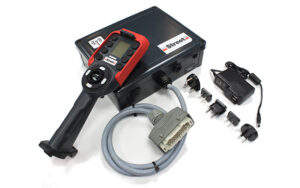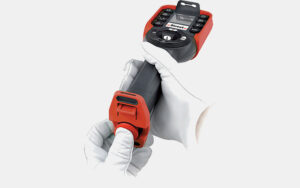What are the benefits?
- Reduced maintenance costs
A radio controlled crane offers flexibility in more ways than you would think. Whilst the traditional push button pendant control is attached to the crane, a radio control crane with a transmitter enables you to store the transmitter away from the working area, reducing its exposure to potentially damaging environments. Unlike a pendant, which stays fixed in position, and more likely to be damaged in the working area.
You can also stock a spare transmitter, should the original be damaged. Pendants do not offer this level of flexibility, meaning a damaged pendant results in downtime until you can get it repaired.
- Potentially less labour intensive
The traditional pendant control system is attached to the crane which limits where an operator can be located in relation to the load being lifted. This method of control can lead to the involvement of additional personnel to assist the operator during the lifting operation. A radio control crane enables the operator to obtain the optimum viewing position for the lifting procedure.
- Increased Safety
Traditional pendant control systems limit where the operator can be located during a lifting procedure. . The risk can increase when loads are lifted, and the operator is in proximity. However, with a radio control crane, operators can perform their lifting procedures away from the load.
The safety benefits of improved visibility during the lifting procedure goes without saying. Operationally however, the operator can work from a clearer viewpoint, making positioning the load much easier.
- Multiple Programming Options
The transmitter and radio control system can be programmed to work around your specific operational needs. The transmitter in a radio control system is often more modern in design and therefore more efficient to use. Lifting procedures that require multiple cranes or hoists to lift a load can benefit from tandem radio control operation which allows one operator to control multiple functions simultaneously on potentially more than 1 x crane.

How do radio control cranes work?
The popularity of radio control cranes has led to significant improvement in their design efficiency and the strength of their connection. Using specific radio frequencies, an extremely secure signal is obtained with the ability to utilise numerous radio control systems across one site simultaneously.
Radio controls are now so advanced, that their reliability or performance cannot be questioned. The determining factor when converting to radio controls, is simply if they would make operational sense for you, the operator.
As well as advancements in the technology, the design of the wireless remote controls have become more ergonomic, and even customisable to your needs. There are push-button, four button, six button, eight button, 12 button, and more to choose from, including LED displays and long-life batteries.
How long to install?
This depends on the complexity of your needs, however a conversion to radio controls is a common procedure and one that shouldn’t take more than one visit by an engineer.

and how much does a radio control crane cost?
Again, due to the popularity of this solution, the cost of the remote control itself and the installation is more affordable than you would think. This does depend on the individual operational needs; however, the multiple benefits add weight to the potential for this initial investment.
Maintenance costs and repair needs are less disruptive to your operation, and less costly than a repair to a traditional pendant.
Get started today! We are confident that our range of radio control crane solutions is the best on the market, you can learn more and contact us here: